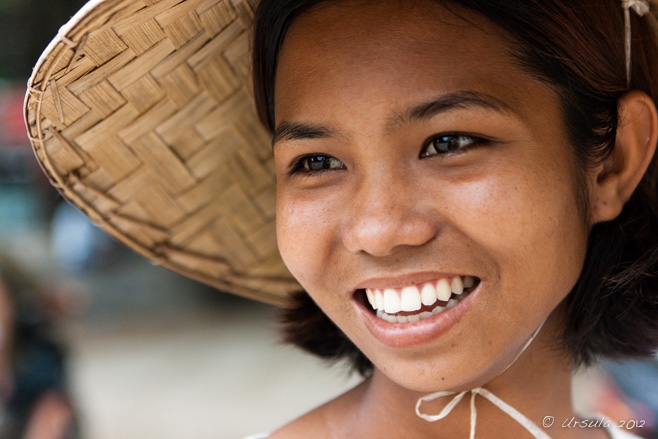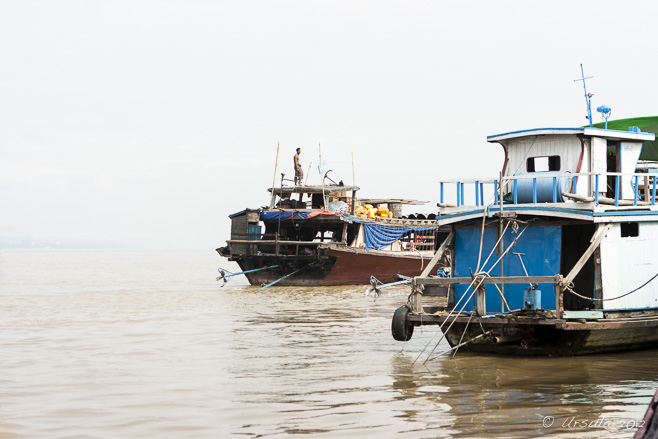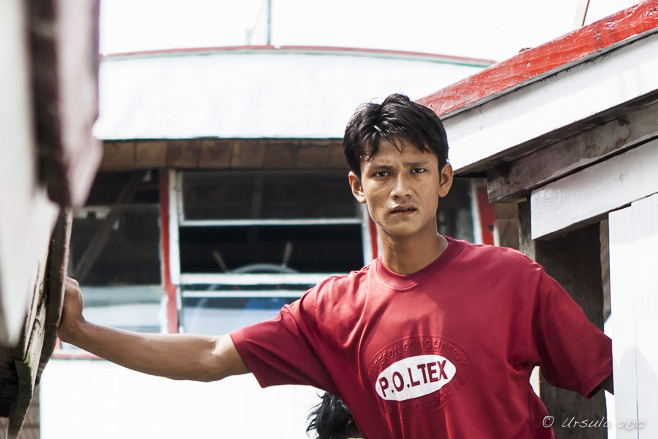
Natural Beauty
A young burmese postcard seller captured me with her simple beauty and natural smile.
“I love the Burman with the blind favouritism born of first impression. When I die I will be a Burman … and I will always walk about with a pretty almond-coloured girl who shall laugh and jest too, as a young maiden ought. She shall not pull a sari over her head when a man looks at her and glare suggestively from behind it, nor shall she tramp behind me when I walk: for these are the customs of India. She shall look all the world between the eyes, in honesty and good fellowship, and I will teach her not to defile her pretty mouth with chopped tobacco in a cabbage leaf, but to inhale good cigarettes of Egypt’s best brand.”
– Rudyard Kipling, 1890
Some things in Myanmar have changed little since Kipling’s time.
The Ayeyarwaddy (Irrawaddy or Ayeyarwady) River, the country’s largest and most important waterway, remains a major transport artery. Numerous wooden boats still ply their trade up and down the “Road to Mandalay” – although the paddle steamers of Kipling’s day have mostly been replaced by noisy diesel and gas motors.
Last September, with photographer Karl Grobl and local guide Mr MM, I travelled the 11 kilometres up the Ayeyarwaddy River from Mandalay to Mingun, a small town in Sagaing.
There was much that Kipling would have found familiar.

Ships in the Heat
Even on the wide Irrawaddy River, the heat shimmers.

Boatman
Getting our boat away from the shore takes human muscle.

Helmsman
Our boat chugs 45 minutes up river.

Life on the River
Fishing for dinner or collecting grasses for building still means getting pretty wet!

The Mingun Pahtodawgyi
Soon, the Mingun Temple, a monumental stupa started by King Bodawpaya in 1790 and never finished, comes into view.

The Prow
Fresh greenery on the bow of our boat protects us from malevolent or unhappy nats or spirits.

On the Mingun Shore
Once we are “docked” on the west bank of the river, vendors in thanakha powder come to greet us.

Street Scene
Streets in Mingun are quiet – travelled by foot or the odd motorcycle.

Bullock Taxi
Alternately, you can hire a bullock cart and driver.
The most famous attraction in Mingun is the beautiful Hsinbyume or Myatheindan Pagoda – built in 1816 and dedicated to the memory of Princess Hsinbyume (Lady of the White Elephant) who died in childbirth – to which I devoted a post to recently. As impressive as Hsinbyume Pagoda is, it is the people on the walk leading to and from it which are the real burmese treasures.

Old Bullock “Taxi” Driver

Cigar and Candle Seller

Selling Silks

Selling Souvenirs

White Elephants
Souvenirs for sale include marionettes – some modelled on elephants in honour of Princess Hsinbyume.

Portrait of a Postcard Seller
This beautiful young woman with her open smile could have been the subject of Kipling’s praises.
You can’t visit Mingun without a look at the Mingun Bell. Weighing in at 90 tons, and built between 1808 and 1810 by the same King Bodawpaya who started the giant stupa, it is one of the largest functioning bells in the world.

Entering the Temple

Zayat or Shelter
The elegant building housing the bell sat under a dramatic sky.

A Smile in the Sky
A circumzenithal (or Bravais’) arc is formed by the refraction of sunlight through ice crystals high up in cirrus clouds. I’ve only ever seen one other.

The Mingun Bell

Monk Collecting for Local Temples

Back to the Boats
“This is Burma and it is unlike any land you know about.”
 – Rudyard Kipling, Letters from the East (1898)
– Rudyard Kipling, Letters from the East (1898)
It is a beautiful place, with beautiful people… I hope it stays that way!
Pictures: 15September2012
























.png)


nice report of Myanmar and very beautiful shots Ursula. Nice sunday and warm greetings, Dietmut
interesting report of Myanmar and nice shot Ursula. Warm greetings and nice day, Dietmut
Hi Dietmut!
It’s very nice to have your company. I’m glad you enjoyed the blog. 🙂